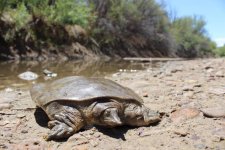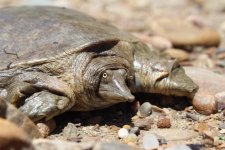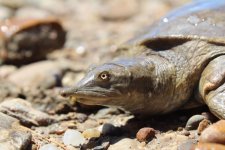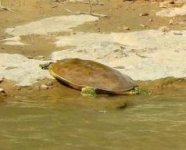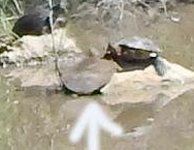| Range: |
 |
| Other Names: |
Spineless Softshell |
| Subspecies: |
Midland Smooth Softshell Apalone mutica mutica |
| Description: |
Adult females 6.5"-14"; males 4.5"-7". Our only softshell without spines, bumps or sandpapery projections on carapace. Shell is quite smooth, hence the name. Also the only softshell without ridges on nostrils. The feet are not strongly streaked or spotted. Male & young: Carapace olive-gray or brown, marked with dots and dashes only a little darker than ground color. Adult female: Mottled with various shades of gray, brown or olive. Young: Plastron paler than underside of carapace. |
| Similar Species: |
Lack of spines, bumps or sandpapery projections on carapace and no ridges on nostrils differentiate it from spiny softshells. |
| Habitat: |
Inhabitant of streams ranging in size from creeks to the mighty Mississippi. Occurs in lakes less frequently than Spiny Softshells, and often is missing where they are abundant, and vice versa. |
| Behavior: |
Powerful swimmers and can run on land with startling speed and agility. They may bask ashore, but only where they have a split second retreat into the water. Frequently lie buried in sand or mud in shallow water with only the eyes and snout exposed where, when the long neck is extended it can take a breath. |
| Hibernation: |
|
| Reproduction: |
Will breed in spring and late summer. Males reach maturity at about four years old, females at about nine. Females will lay two or more clutches per season averaging 11(3-33) eggs each, but both clutch number and size depends directly on the size of the female. They dig shallow nests in open areas of sandbars and sandy banks. Eggs are spherical with thick brittle white shells. Incubation tme varies based on temperature, but is usually 65-77 days. Hatchlings average about 1" CL and double in length by the end of their first year. Females tend to grow faster than males. |
| Diet: |
Carnivorous, prey items include a wide variety of aquatic invertebrates, especially arthropods, but fishes, amphibians, reptiles and carrion are eaten when available. |


